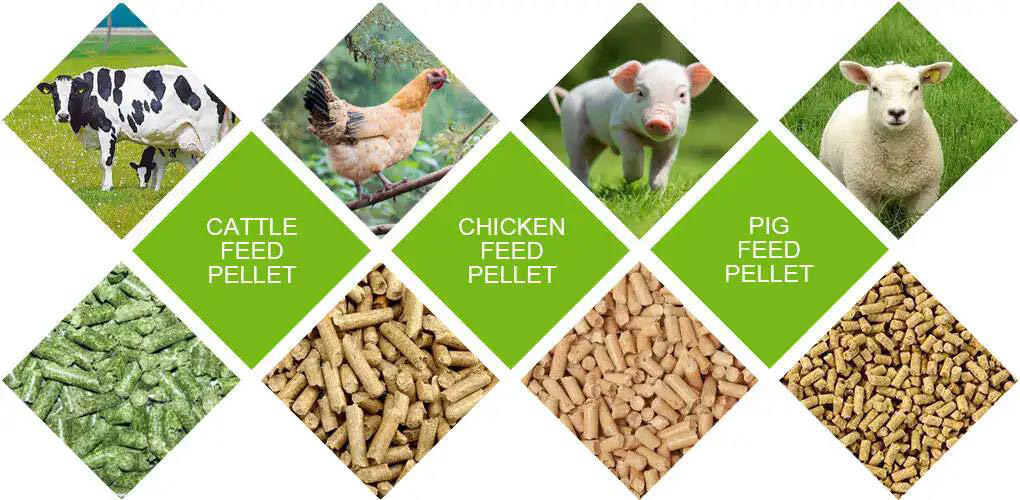sheep feed mill
A sheep feed mill is an industrial facility specialized in producing feed for sheep. Its primary function is to process various raw materials (such as corn, soybean meal, wheat bran, etc.) into feed that meets the nutritional requirements of sheep.
sheep feed mill Introduction
A sheep feed mill is an industrial facility specialized in producing feed for sheep. Its primary function is to process various raw materials (such as corn, soybean meal, wheat bran, etc.) into feed that meets the nutritional requirements of sheep. These feeds are formulated based on the specific needs of different breeds of sheep (such as meat sheep, wool sheep, etc.) and their growth stages (such as lambs, adult sheep, etc.) to ensure balanced nutrition, promoting their healthy growth and efficient production. A sheep feed mill typically includes sections for raw material storage, processing and production, quality control, and packaging to meet market demands and the needs of sheep farmers.


Main Functions of a Sheep Feed Mill
Feed Formulation
Designing feed formulations based on the nutritional requirements of different breeds and growth stages of sheep.
Raw Material Procurement and Management
Procuring high-quality raw materials such as corn, soybean meal, and wheat bran from reliable suppliers and managing inventory effectively.
Processing and Production
Using equipment for grinding, mixing, and pelletizing to process raw materials into nutritionally balanced feed pellets or powder.
Quality Control
Implementing rigorous quality control measures during production to ensure the safety, nutritional balance, and consistent quality of the feed.
Packaging and Distribution
Standardizing packaging of the produced feed for easy storage, transportation, and sale to meet the needs of various sheep farms.
Technical Support and Services
Providing technical consultation, after-sales service, and training to support sheep farmers in production management and technical application.


Main Components of a Sheep Feed Mill
Raw Material Reception and Storage Area
Used for receiving and storing various raw materials such as corn, soybean meal, wheat bran, etc., ensuring the safety and freshness of the materials.
Grinding Equipment
Crushes large pieces of raw materials into smaller particles or powder suitable for further processing.
Mixing Equipment
Blends different types and proportions of raw materials to ensure the uniformity and consistency of the feed.
Pelleting Equipment
Processes the mixed feed materials into pellets using high temperature and pressure to enhance palatability and storage stability.
Cooling Equipment
Cools the newly produced hot feed pellets to prevent clumping and mold formation.
Screening Equipment
Removes any undersized or oversized pellets produced during pelleting to ensure consistent quality and particle size of the finished feed.
Packaging Equipment
Packages the quality-checked finished feed into different sizes of bags or bulk containers for storage and transportation.
Quality Control Laboratory
Conducts nutritional and safety tests on raw materials and finished feed to ensure compliance with standards and requirements.


Key Advantages of a Sheep Feed Mill
Customized Feed Formulation
The ability to formulate precise feed recipes tailored to the specific nutritional needs of different breeds and growth stages of sheep.
High-Quality Raw Material Procurement
Procuring high-quality raw materials and ensuring their freshness and safety through effective management to enhance feed quality.
Advanced Processing Technologies
Applying advanced techniques such as grinding, mixing, and pelleting to ensure feed uniformity and stability, improving palatability and nutritional value.
Strict Quality Control
Implementing rigorous quality control measures during production, including nutritional and safety testing in quality control laboratories, to ensure compliance with standards and safety requirements.
Economic Efficiency
Lowering feed production costs and improving economic efficiency through large-scale production and cost management optimization.
Convenient Packaging and Distribution
Using standardized packaging and distribution systems to facilitate customer selection and usage, ensuring freshness and safety of the feed.
Technical Support and Services
Providing professional technical support, after-sales service, and farming advice to help customers enhance farming efficiency and management practices.
Application of sheep feed mill
Typically, the production of animal feed processing plant uses raw materials such as corn, soybeans, wheat, and other nutrients as the formula. Our small feed mill plant are specially used to produce feed for poultry, livestock, pigs, horses, cattle, sheep, chickens, ducks, goose and other animals.For different animals, with different growth cycles, (chicks, suckling pigs, calves, etc.), the feed pellet size required is different, but our feed production line only needs to replace ring molds with different apertures or use a pellet crumbler to reach the required size.

Parameter of sheep feed mill
| Model | Capacity | Main Motor Power | Feeder Motor Power | Conditioner Power | Dia. of Ring Die | Pellet Size |
| SZLH250 | 1-2T/H | 22KW | 0.75kw | 1.5kw | 250mm | 2-12mm |
| SZLH320 | 3-4T/H | 37KW | 1.5kw | 2.2kw | 320mm | 2-12mm |
| SZLH350 | 5-7T/H | 55KW | 1.5kw | 3kw | 350mm | 2-12mm |
| SZLH420 | 8-12T/H | 110KW | 1.5kw | 7.5kw | 420mm | 2-12mm |
| SZLH508 | 10-18T/H | 160KW | 2.2kw | 11kw | 508mm | 2-12mm |
| SZLH558 | 15-25T/H | 180KW | 2.2kw | 11kw | 558mm | 2-12mm |
| SZLH678 | 20-30T/H | 220KW | 2.2kw | 11kw | 678mm | 2-12mm |
| SZLH768 | 25-42T/H | 280KW | 2.2kw | 11kw | 768mm | 2-12mm |






